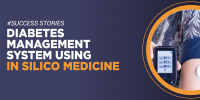Explore the fascinating journey of diabetes care, from ancient discoveries to life-saving insulin and AI-driven closed-loop systems. Learn how computer models now personalise treatments, transforming lives and shaping a hopeful future for a cure.

Throughout history, the brightest scientific minds have sought to understand diabetes, reflecting the knowledge and technology of their time.
This journey begins over 3,500 years ago in ancient Egypt, where the Ebers Papyrus described a mysterious ailment as a “too great emptying of the urine”. This was the recorded description of polyuria, a key symptom of diabetes. Around the same period, physicians in India observed that some people’s urine attracted ants. They called the condition Madhumeha, or “honey urine”, referring to glycosuria, the presence of glucose in urine.
By 500 BCE, Indian physicians Sushruta and Charaka expanded on these observations. They identified two distinct patterns of the disease: one affecting the young and another linked to those who were overweight. This early insight remarkably foreshadowed the modern classification of Type 1 and Type 2 diabetes, two of the most common forms of the condition.
Today, we know diabetes as a group of disorders caused by problems with insulin, a hormone that allows glucose to enter cells and provide energy. In Type 1 diabetes, the immune system mistakenly attacks the pancreas’s insulin-producing cells. This condition currently has no cure, cannot be prevented, and typically develops in children and young adults. Type 2 diabetes, in contrast, is largely influenced by lifestyle factors such as inactivity and being overweight, making it largely preventable.
For centuries, diabetes was a death sentence, but this changed in 1921 when insulin was discovered. The first insulin treatment saved the life of a 14-year-old boy, Leonard Thompson, marking a pivotal moment in medical history.
However, early insulin production was far from ideal. For decades, it was extracted from the pancreases of pigs and cows in a labor-intensive process requiring thousands of organs to produce small amounts of insulin. While lifesaving, this insulin could also cause allergic reactions being similar – but not identical– to human insulin.
A major breakthrough came in 1982 with the introduction of genetically engineered human insulin, the first biotech drug approved by the FDA. This innovation made insulin purer, more affordable, and widely accessible, representing a monumental leap forward.
With insulin discovered and refined, attention turned to improving its administration. For decades, managing diabetes meant frequent finger pricks to check blood sugar levels and manual insulin injections, but the arrival of smart technology revolutionised this process.
Today, automated insulin delivery systems are transforming diabetes care. These systems include a sensor placed under the skin to continuously monitor glucose levels and an insulin pump to automatically inject precise doses to the bloodstream. However, the real magic lies in the control algorithm powered by computer models. These algorithms analyse data in real time, learning and adapting to the user’s unique needs, such as changes in activity, diet, or overall health. They personalise insulin delivery to prevent dangerous blood sugar highs and lows, inching closer to mimicking a healthy pancreas.
Since their debut in 2017, closed-loop systems have turned what was once a constant struggle into a manageable routing. They are a testament to the transformative power of computer modelling and simulation in healthcare.
The story of diabetes is far from over. Continuous advancements in artificial intelligence, biotechnology, and medicine bring us closer to a future where diabetes is not just managed, but cured.
Further resources: